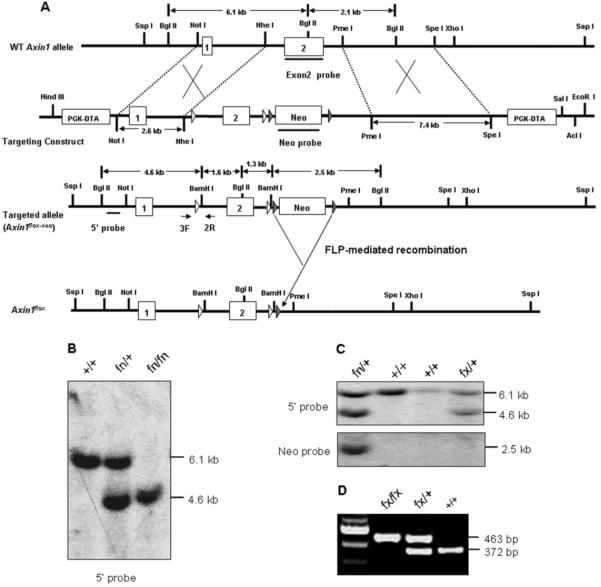FIG. 1.
Generation of mice carrying Axin1fn (flox-neo) and Axin1fx/fx alleles. A: Targeting construct for inactivation of the Axin1 gene. The wild-type Axin1 locus, targeting construct, targeted allele, and flox allele are shown schematically. The boxes numbered 1–2 represent the exons 1 and 2. Open triangles represent the loxP sequence. The filled triangles represent the frt sites. The PKG-promoter-driven DT-A and Neo-TK cassette are indicated by boxes. The bars represent the probes for Southern blot analysis. The flox allele was generated by crossing targeted allele with FLPeR mice. A 2.6-kb NotI/NheI fragment represents 5′ homologous arm. A 7.4-kb PmeI/SpeI fragment represents the 3′ homology arm. The arrows indicate the priming position for primers 3F and 2R, which were used to detect both wild-type and floxed alleles. B: Southern blot analysis of BamHI-BglII genomic DNA prepared from tail biopsies of wild-type (+/+), heterozygous (fn/+, fn denotes floxP-neo), and homozygous (fn/fn) Axin1 flox-neo mice using 5′ external probe. Presence of wild-type and targeted alleles are indicated by 6.1-kb and 4.6-kb fragments, respectively. C: Southern blot analysis of genomic DNA using 5′ probe and Neo probe confirmed that Neo-TK cassette was removed by the Flp recombinase. The 2.5-kb band represents the Neo-TK cassette. D: A representative agarose gel image of PCR genotyping using primers 3F and 2R. A 372-bp band represents wild-type alleles, and the 463-bp band represents the floxed allele.

